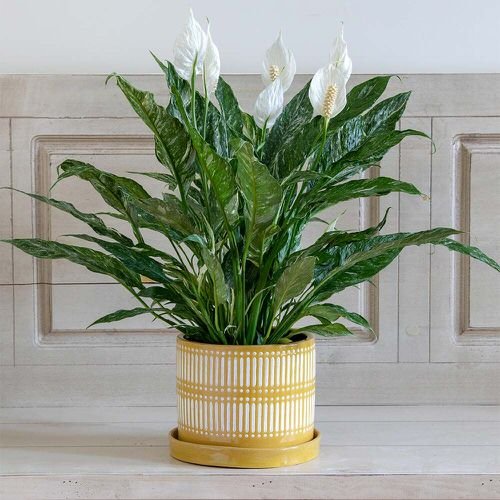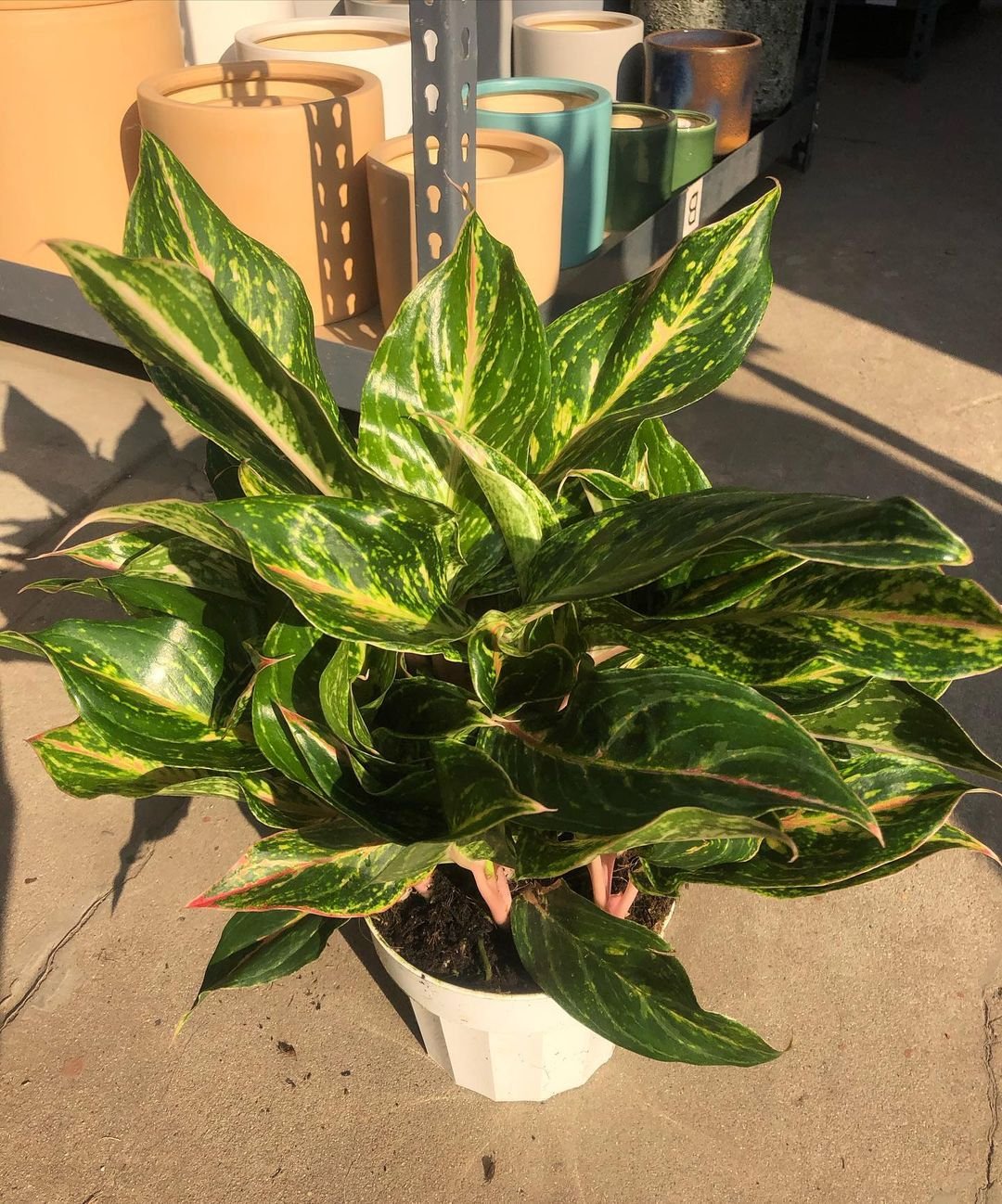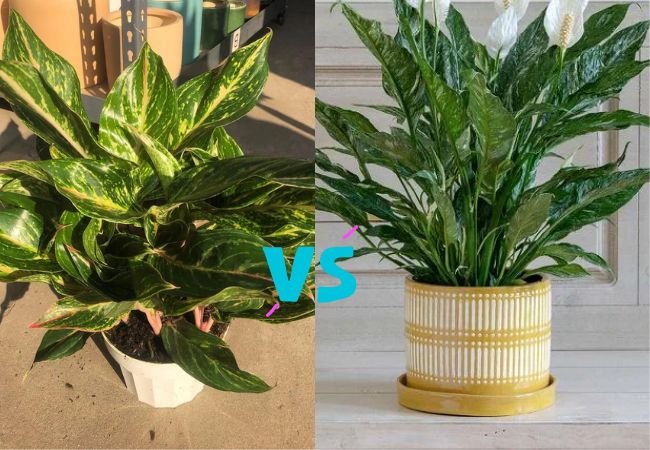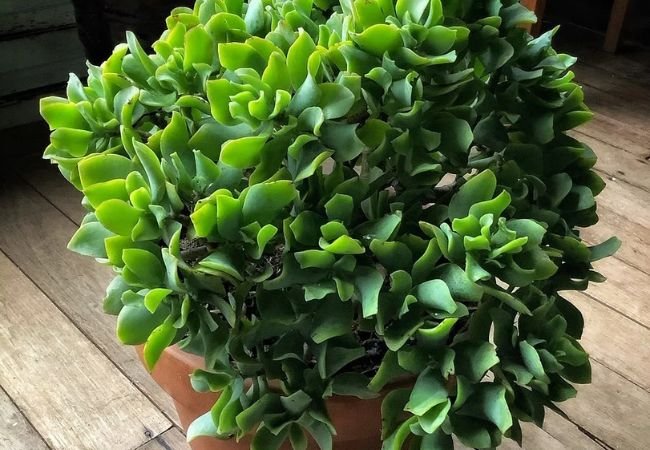Learn how to differentiate between Peace Lily and Chinese Evergreen plants. Discover their unique characteristics, care requirements and tips to keep these popular houseplants thriving.
Peace Lily and Chinese Evergreens are both popular houseplants known for their attractive foliage and easy care. However, they’re distinct plants with different needs. This guide will help you tell them apart and provide the best care for each.
Introduction to Peace Lily and Chinese Evergreen
Before we dive into the differences, let’s briefly introduce each plant:
Peace Lily (Spathiphyllum)

Here is a completed chart with detailed information about Peace Lily:
| Category | Details |
|---|---|
| Botanical Name | Spathiphyllum spp. |
| Common Name | Peace Lily |
| Plant Zone | 10-11 (often grown indoors) |
| Sun Exposure | Low to bright indirect light |
| Soil Type | Well-drained, rich in organic matter |
| Watering | Keep soil consistently moist but not waterlogged, water when the top inch of soil is dry |
| Growth Habit | Upright, clumping |
| Height/Spread | 1-3 feet tall, 1-2 feet wide |
| Special Features | Elegant white flowers, large green leaves, air-purifying properties, prefers indoor environments, easy to care for, can tolerate low light conditions |
- Native to tropical regions of the Americas and Southeast Asia
- Known for its elegant white flowers and dark green leaves
- Popular as an air-purifying plant
Chinese Evergreen (Aglaonema)

Here is a completed chart with detailed information about Chinese Evergreen:
| Category | Details |
|---|---|
| Botanical Name | Aglaonema spp. |
| Common Name | Chinese Evergreen |
| Plant Zone | 10-11 (often grown indoors) |
| Sun Exposure | Low to bright indirect light |
| Soil Type | Well-drained, rich in organic matter |
| Watering | Allow top inch of soil to dry out between waterings, avoid waterlogging |
| Growth Habit | Upright, bushy |
| Height/Spread | 1-3 feet tall, 1-2 feet wide |
| Special Features | Attractive foliage with various patterns and colors, low-maintenance, air-purifying, suitable for indoor environments, tolerates low light conditions |
- Native to tropical and subtropical regions of Asia
- Prized for its variegated leaves in various color patterns
- Also recognized for air-purifying qualities
How to Differentiate Peace Lily and Chinese Evergreen
While both plants have lush green foliage, there are key differences:
1. Flowers
- Peace Lily: Produces distinctive white, spoon-shaped flowers (actually modified leaves called spathes)
- Chinese Evergreen: Rarely flowers indoors; when it does, produces small, unremarkable flowers
2. Leaf Shape and Texture
- Peace Lily: Oval, pointed leaves with a glossy texture
- Chinese Evergreen: Broader, often patterned leaves with a more matte finish
3. Growth Pattern
- Peace Lily: Grows in a clumping pattern
- Chinese Evergreen: Tends to grow in a more spreading pattern
4. Size
- Peace Lily: Can grow up to 3 feet tall indoors
- Chinese Evergreen: Usually stays smaller, typically 1-2 feet tall
Care Requirements for Peace Lily
Now that we can identify a Peace Lily, let’s look at how to care for it:
1. Light
- Prefers low to medium indirect light
- Can tolerate lower light conditions, but may not flower
2. Water
- Keep soil consistently moist but not waterlogged
- Water when top inch of soil feels dry
3. Humidity
- Enjoys high humidity
- Mist leaves regularly or use a pebble tray
4. Temperature
- Prefers temperatures between 65-80°F (18-27°C)
- Avoid cold drafts
5. Soil
- Well-draining, rich potting mix
- Add perlite or orchid bark for better drainage
6. Fertilizer
- Feed monthly during growing season with balanced, water-soluble fertilizer
- Reduce feeding in winter
Care Requirements for Chinese Evergreen
Chinese Evergreens have slightly different care needs:
1. Light
- Tolerates low light but prefers medium, indirect light
- Variegated varieties need brighter light to maintain their color
2. Water
- Allow top 1-2 inches of soil to dry between waterings
- Reduce watering in winter
3. Humidity
- Adapts to average home humidity
- Appreciates occasional misting
4. Temperature
- Prefers warm temperatures, 60-75°F (16-24°C)
- Sensitive to cold; keep away from drafts
5. Soil
- Well-draining potting mix
- Add perlite for extra drainage
6. Fertilizer
- Feed every 6-8 weeks during growing season
- Use a balanced, water-soluble fertilizer
Common Problems and Solutions
Both plants can face similar issues. Here’s how to address them:
1. Yellow Leaves
- Peace Lily: Often due to overwatering or poor drainage
- Chinese Evergreen: Can be caused by overwatering or too much direct sunlight
Solution: Adjust watering schedule and check light conditions
2. Brown Leaf Tips
- Both plants: Usually indicates low humidity or water quality issues
Solution: Increase humidity and use filtered water if possible
3. Pests
- Both plants can be susceptible to mealybugs, spider mites and scale
Solution: Regularly inspect plants and treat with neem oil or insecticidal soap if pests are found
4. Drooping Leaves
- Peace Lily: Often dramatically droops when thirsty
- Chinese Evergreen: Drooping can indicate overwatering or underwatering
Solution: Check soil moisture and adjust watering as needed
Propagation Methods
Knowing how to propagate these plants can help you expand your collection:
Peace Lily Propagation
- Division:
- Gently separate offshoots with roots from the main plant
- Replant in fresh potting mix
Chinese Evergreen Propagation
- Stem Cuttings:
- Cut a stem with at least two leaves
- Root in water or moist potting mix
- Division:
- Similar to Peace Lily, separate rooted sections
Toxicity Concerns
It’s important to note the toxicity of these plants:
- Peace Lily: Toxic to cats and dogs if ingested
- Chinese Evergreen: Also toxic to pets if ingested
Keep both plants out of reach of pets and children.
Decorating with Peace Lilies and Chinese Evergreens
Both plants can enhance your home decor:
- Peace Lilies: Elegant addition to living rooms or offices
- Chinese Evergreens: Great for adding color to low-light corners
Consider grouping them with other plants for a lush, tropical feel.
While Peace Lilies and Chinese Evergreens may seem similar at first glance, they have distinct characteristics and care requirements. By understanding these differences, you can provide the best care for each plant and enjoy their beauty in your home.
Remember, the key to success with any houseplant is observation. Pay attention to how your plant responds to its environment and care routine and adjust as needed. With proper care, both Peace Lilies and Chinese Evergreens can thrive and beautify your space for years to come.
Whether you choose a Peace Lily for its elegant flowers or a Chinese Evergreen for its colorful foliage, both plants offer the benefits of improved air quality and a touch of nature in your home. Happy gardening!








Leave a Reply